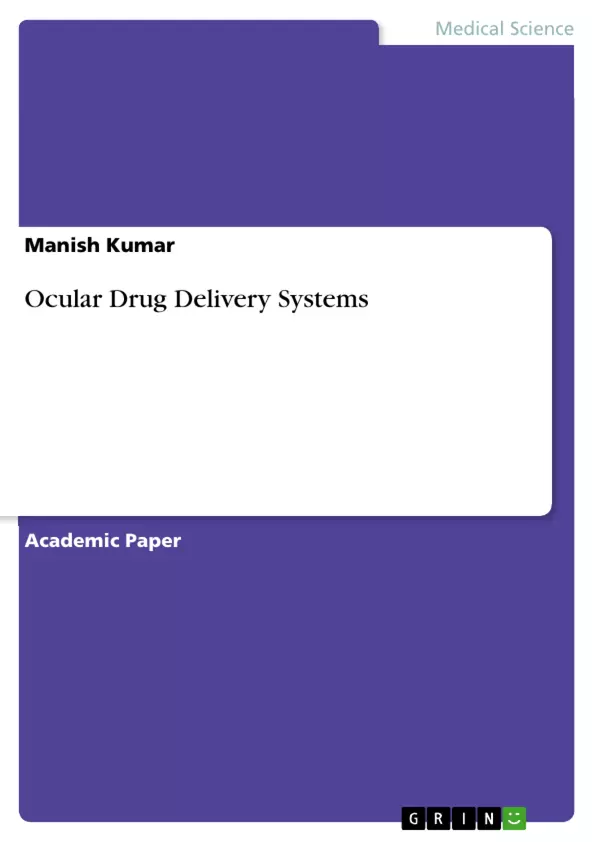Ocular drug delivery plays a vital role in the treatment of various eye diseases and conditions. The unique anatomical and physiological characteristics of the eye pose significant challenges for effective drug delivery. Over the years, extensive research efforts have been dedicated to developing innovative strategies and formulations to overcome these challenges and improve therapeutic outcomes. This review provides an overview of recent advances in ocular drug delivery, highlighting the key challenges faced and discussing the potential future directions in this field.
The first section of the review focuses on the barriers to ocular drug delivery, including the tear film, cornea, conjunctiva, and blood-ocular barriers. These barriers limit the bioavailability and efficacy of drugs administered to the eye. Strategies to bypass or overcome these barriers, such as the use of penetration enhancers, nanoparticles, and prodrug approaches, are discussed.
The second section explores various ocular drug delivery systems, including eye drops, ophthalmic gels, ocular inserts, and contact lens-based delivery systems. Each system is examined in terms of its advantages, limitations, and recent advancements. Special attention is given to sustained drug release systems that aim to prolong drug residence time on the ocular surface and improve patient compliance.
Next, the review delves into the role of nanotechnology in ocular drug delivery. Nanoparticles, liposomes, and nanomicelles have shown promise in improving drug solubility, stability, and ocular bioavailability. The use of novel nanomaterials and their surface modifications for targeted drug delivery to specific ocular tissues is also discussed.
Furthermore, the review highlights emerging techniques in ocular drug delivery, such as microneedles, hydrogels, and gene therapy-based approaches. These technologies offer exciting prospects for precise and personalized treatment of ocular diseases.
Finally, the review concludes by discussing the regulatory considerations, safety aspects, and clinical translation of ocular drug delivery systems. The importance of collaboration between researchers, clinicians, and regulatory bodies in advancing this field is emphasized.
Inhaltsverzeichnis (Table of Contents)
- NEED FOR OCULAR DRUG DELIVERY SYSTEMS
- ANATOMICAL AND PHYSIOLOGICAL CONSTRAINTS TO TOPICAL OCULAR DRUG THERAPY
- The Anatomy of the Eye
- Fibrous Tunic
- Vascular Tunic
- Retina
- Interior of The Eyeball
- Aqueous Humor
- ABSORPTION OF DRUGS IN EYE
- DRUG ELIMINATION FROM LACRIMAL FLUID
Zielsetzung und Themenschwerpunkte (Objectives and Key Themes)
This text explores the challenges and complexities associated with ocular drug delivery systems. It investigates the anatomical and physiological barriers that hinder effective drug absorption and delivery within the eye. The text highlights the importance of maximizing ocular drug absorption while minimizing systemic absorption. It delves into the mechanisms of drug elimination from the eye, examining factors that impact drug bioavailability.
- Anatomical and Physiological Constraints of the Eye
- Drug Absorption Mechanisms in the Eye
- Drug Elimination from the Lacrimal Fluid
- Challenges of Ocular Drug Delivery Systems
- Factors Influencing Drug Bioavailability
Zusammenfassung der Kapitel (Chapter Summaries)
- NEED FOR OCULAR DRUG DELIVERY SYSTEMS: This chapter introduces the field of ophthalmic drug delivery, emphasizing its challenges and the importance of overcoming limitations posed by the eye's unique anatomy and physiology. It discusses the shortcomings of traditional topical drug delivery methods, such as solutions and suspensions, which lead to rapid drug elimination and limited bioavailability.
- ANATOMICAL AND PHYSIOLOGICAL CONSTRAINTS TO TOPICAL OCULAR DRUG THERAPY: This chapter delves into the intricate anatomy of the eye, highlighting the structures that present barriers to drug delivery. It examines the fibrous tunic, vascular tunic, and retina, discussing their roles in drug absorption and elimination. The chapter also explores the interior of the eyeball, including the anterior and vitreous chambers and the aqueous humor.
- ABSORPTION OF DRUGS IN EYE: This chapter discusses the absorption of drugs into the eye, emphasizing that absorption can occur through corneal and non-corneal routes. It highlights the importance of corneal absorption for maximizing drug penetration into the aqueous humor. The chapter underscores the goal of ophthalmic drug delivery systems, which is to optimize ocular drug absorption while minimizing systemic absorption.
- DRUG ELIMINATION FROM LACRIMAL FLUID: This chapter explores the various mechanisms responsible for drug elimination from the lacrimal fluid. It examines how drugs are drained from the conjunctival sac, cleared from the precorneal area, and absorbed systemically. The chapter highlights the significant challenges posed by these elimination mechanisms, which often lead to poor bioavailability.
Schlüsselwörter (Keywords)
The key themes of this text center around ocular drug delivery systems, anatomical and physiological barriers to drug absorption, drug bioavailability, precorneal constraints, and systemic absorption. It explores the challenges of delivering drugs effectively to the eye, considering factors such as tear turnover, nasolacrimal drainage, and conjunctival absorption.
- Arbeit zitieren
- Manish Kumar (Autor:in), 2023, Ocular Drug Delivery Systems, München, GRIN Verlag, https://www.hausarbeiten.de/document/1369759


